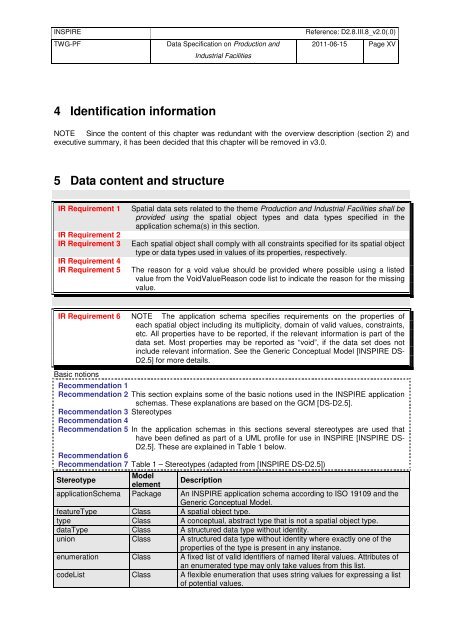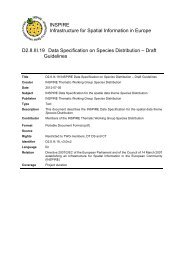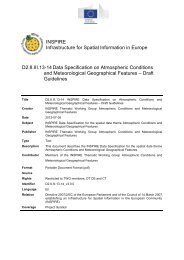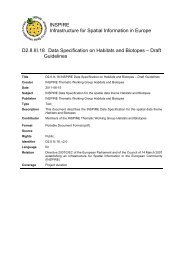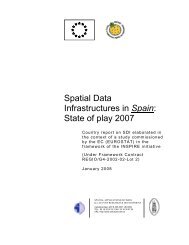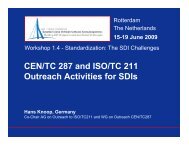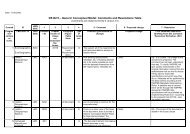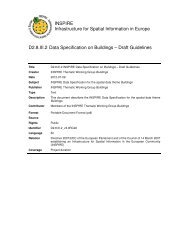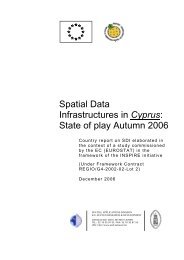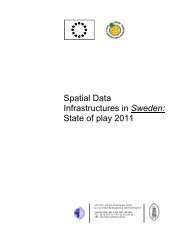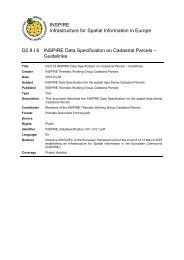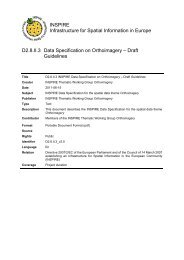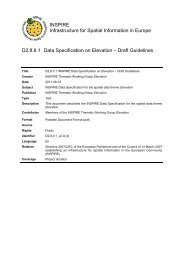Production and Industrial Facilities - INSPIRE - Europa
Production and Industrial Facilities - INSPIRE - Europa
Production and Industrial Facilities - INSPIRE - Europa
Create successful ePaper yourself
Turn your PDF publications into a flip-book with our unique Google optimized e-Paper software.
<strong>INSPIRE</strong> Reference: D2.8.III.8_v2.0(.0)<br />
TWG-PF Data Specification on <strong>Production</strong> <strong>and</strong><br />
4 Identification information<br />
<strong>Industrial</strong> <strong>Facilities</strong><br />
2011-06-15 Page XV<br />
NOTE Since the content of this chapter was redundant with the overview description (section 2) <strong>and</strong><br />
executive summary, it has been decided that this chapter will be removed in v3.0.<br />
5 Data content <strong>and</strong> structure<br />
IR Requirement 1 Spatial data sets related to the theme <strong>Production</strong> <strong>and</strong> <strong>Industrial</strong> <strong>Facilities</strong> shall be<br />
provided using the spatial object types <strong>and</strong> data types specified in the<br />
application schema(s) in this section.<br />
IR Requirement 2<br />
IR Requirement 3 Each spatial object shall comply with all constraints specified for its spatial object<br />
type or data types used in values of its properties, respectively.<br />
IR Requirement 4<br />
IR Requirement 5 The reason for a void value should be provided where possible using a listed<br />
value from the VoidValueReason code list to indicate the reason for the missing<br />
value.<br />
IR Requirement 6 NOTE The application schema specifies requirements on the properties of<br />
each spatial object including its multiplicity, domain of valid values, constraints,<br />
etc. All properties have to be reported, if the relevant information is part of the<br />
data set. Most properties may be reported as “void”, if the data set does not<br />
include relevant information. See the Generic Conceptual Model [<strong>INSPIRE</strong> DS-<br />
D2.5] for more details.<br />
Basic notions<br />
Recommendation 1<br />
Recommendation 2 This section explains some of the basic notions used in the <strong>INSPIRE</strong> application<br />
schemas. These explanations are based on the GCM [DS-D2.5].<br />
Recommendation 3 Stereotypes<br />
Recommendation 4<br />
Recommendation 5 In the application schemas in this sections several stereotypes are used that<br />
have been defined as part of a UML profile for use in <strong>INSPIRE</strong> [<strong>INSPIRE</strong> DS-<br />
D2.5]. These are explained in Table 1 below.<br />
Recommendation 6<br />
Recommendation 7 Table 1 – Stereotypes (adapted from [<strong>INSPIRE</strong> DS-D2.5])<br />
Stereotype<br />
Model<br />
element<br />
Description<br />
applicationSchema Package An <strong>INSPIRE</strong> application schema according to ISO 19109 <strong>and</strong> the<br />
Generic Conceptual Model.<br />
featureType Class A spatial object type.<br />
type Class A conceptual, abstract type that is not a spatial object type.<br />
dataType Class A structured data type without identity.<br />
union Class A structured data type without identity where exactly one of the<br />
properties of the type is present in any instance.<br />
enumeration Class A fixed list of valid identifiers of named literal values. Attributes of<br />
an enumerated type may only take values from this list.<br />
codeList Class A flexible enumeration that uses string values for expressing a list<br />
of potential values.


